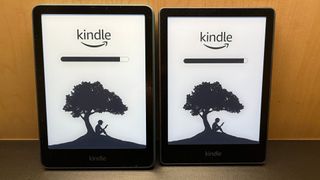I love my Kindle but the one thing I don't like won't change anytime soon – and now I know why
Bad placement

It's no secret that I love my Kindle; not just the new ultra-fast Amazon Kindle Paperwhite 12th Gen, but virtually all the Kindles that have come before it. It's a fantastic purpose-built E Ink reading device that lets me read dozens of books without a recharge. And yet it has one feature that has caused me – and more than a few others – a fair bit of frustration: the power button.
Kindles are pervasive. During the recent Kindle launch event, Amazon Devices Lead Panos Panay said the company is this year seeing the highest sales of Kindles in over a decade. That means many of you are discovering the somewhat odd placement of the Kindle power button for the first time. If you have your Kindle nearby, pick it up and examine the bottom edge. Next to the USB-C port is the shiny little power button.
There is nothing wrong with this button. It has no special powers beyond turning your Kindle on or waking it Kindle from sleep; a long press will turn off the Kindle completely, but given its power-sipping capabilities, who does that?
The problem with this placement, though, is that it seems to not take into account how some of us read with these E Ink devices. Usually, I'm reading my Kindle in bed with it propped up on some pillows, but I've also read with it on my lap or balancing on my backpack or an airplane's tray table. This means most of the weight of the ereader is resting on that little power button. It's not uncommon for me to forget, and maybe rest the weight of my hand on the Kindle while I hold it; other times I'm using it hands-free, and the Kindle is wedged between the top of a table and the back of the seat in front of me, and the person in that seat leans back just a little. It's at these times that the power button gets pressed, and the Kindle goes to sleep or, even worse, shuts down. This invariably happens during the most important passage of a 400-page book. It never fails. I cry out in surprise as I realize my mistake.
Misplaced

I also feel that Amazon has made a mistake. Why is the power button there? I'm not the only one asking this question. It's quite easy to find a few Reddit threads addressing the question. In these threads are various plausible explanations for the placement of the button, such as the location of the motherboard (which, based on teardowns, does sit at the bottom of the device), the need to balance the weight of the devices, or the possible necessary proximity to the USB-C power port.
None, though, are quite right.
When I spoke to Amazon's Kindle hardware lead Kevin Keith about the issue, he offered a different explanation, but not before trying to solve my problem.
Get daily insight, inspiration and deals in your inbox
Sign up for breaking news, reviews, opinion, top tech deals, and more.
First Keith asked if I had a cover for my Kindle, because the thickness of the cover would immediately mitigate this issue by putting the power button level with the surface of the Kindle cover. No more accidental presses. But I hate covers. I'm a travel-light kind of guy, and I try to shed anything that adds any unnecessary weight. Kindles are plenty tough in my opinion (the Signature models are waterproof) and don't need that extra protection. Keith joked that they needed to get me a cork cover which would be a lot lighter.
And that's when Keith opened up about the real reason for the button placement.
"We've looked at that because we've gotten this feedback and a lot of it is to keep the dimensions really tight, and so if you remember what Panos was saying, the thing you don't want to mess with, with a Paperwhite, is how it feels in your hand for long reading sessions of one-handed reading, and so that's why when we increase the screen viewing size we always have to shrink the bezels. And the [fact that the] button has to be near the light guide is essentially what is driving this."
Okay, I know, that doesn't entirely clear this up, but the thinking here appears to be related to, for one thing, cutting down the distance between components, especially the power and the panel that guides the LED lighting (which is arrayed across the base of the Kindle) across the entire screen. It also means you're not reaching across the screen to power up the Kindle, and thereby not covering the light sensor on Paperwhite Signature editions that automatically adjust to light conditions (granted the sensor will catch up in short order and adjust the lighting as soon as you move your hand). Finally, Amazon isn't putting the power button on either side of the Kindle, or even the back, because it might change how the Kindle feels in your hand.
Put another way, Amazon obviously has no intention of moving that power button any time soon. Put yet another way: have you thought about buying a case?
You might also like

A 38-year industry veteran and award-winning journalist, Lance has covered technology since PCs were the size of suitcases and “on line” meant “waiting.” He’s a former Lifewire Editor-in-Chief, Mashable Editor-in-Chief, and, before that, Editor in Chief of PCMag.com and Senior Vice President of Content for Ziff Davis, Inc. He also wrote a popular, weekly tech column for Medium called The Upgrade.
Lance Ulanoff makes frequent appearances on national, international, and local news programs including Live with Kelly and Mark, the Today Show, Good Morning America, CNBC, CNN, and the BBC.
Most Popular



